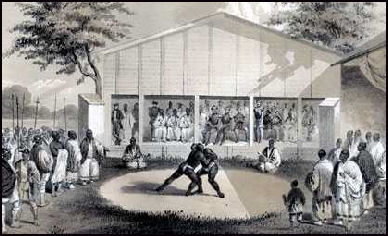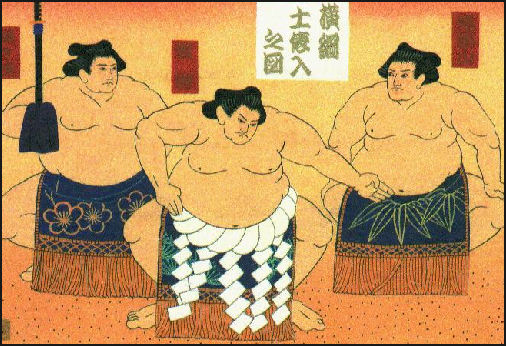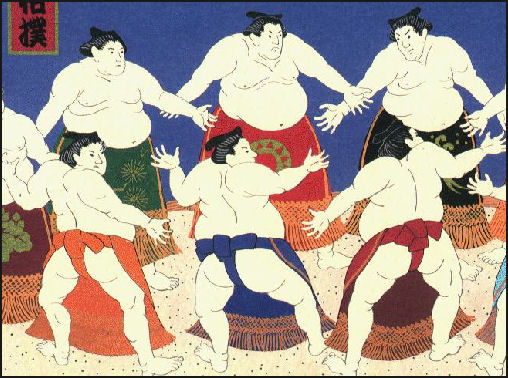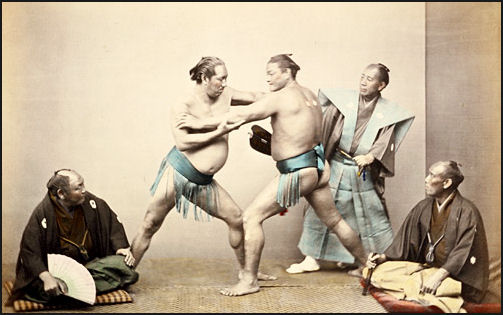SUMO HISTORY

Sumo exhibition for Adm. Perry
and the first Americans in Japan
in the 19th century Sumo wrestling is the national sport of Japan. Once patronized by the emperors, Sumo's origins go back at least 1,500 years, making it the world's oldest organized sport. It probably evolved out of Mongolian, Chinese and Korean wrestling. In its long history sumo has gone through many changes and many of the rituals that go along the sport that seem old were in fact conceived in the 20th century. [Source: T.R. Reid, National Geographic, July 1997]
The word “sumo”is written with the Chinese characters for “mutual bruising.” Although sumo’s history goes back to ancient times, it became a professional sport in the early Edo period (1600-1868).
The main sumo organizing body is the Japan Sumo Association (JSA). It is made up of stablemasters, the equivalent of sumo coaches and managers. There were 53 stables as of 2008.
Websites and Resources
Links in this Website: SPORTS IN JAPAN (Click Sports, Recreation, Pets ) Factsanddetails.com/Japan ; SUMO RULES AND BASICS Factsanddetails.com/Japan ; SUMO HISTORY Factsanddetails.com/Japan ; SUMO SCANDALS Factsanddetails.com/Japan ; SUMO WRESTLERS AND SUMO LIFESTYLE Factsanddetails.com/Japan ; FAMOUS SUMO WRESTLERS Factsanddetails.com/Japan ; FAMOUS AMERICAN AND FOREIGN SUMO WRESTLERS Factsanddetails.com/Japan ; MONGOLIAN SUMO WRESTLERS Factsanddetails.com/Japan
Good Websites and Sources: Nihon Sumo Kyokai (Japan Sumo Association) official site sumo.or ; Sumo Fan Magazine sumofanmag.com ; Sumo Reference sumodb.sumogames.com ; Sumo Talk sumotalk.com ; Sumo Forum sumoforum.net ; Sumo Information Archives banzuke.com ; Masamirike’s Sumo Site accesscom.com/~abe/sumo ; Sumo FAQs scgroup.com/sumo ; Sumo Page http://cyranos.ch/sumo-e.htm ; Szumo. Hu, a Hungarian English language sumo site szumo.hu ; Books : “The Big Book of Sumo” by Mina Hall; “Takamiyama: The World of Sumo” by Takamiyama (Kodansha, 1973); “Sumo” by Andy Adams and Clyde Newton (Hamlyn, 1989); “Sumo Wrestling” by Bill Gutman (Capstone, 1995).
Sumo Photos, Images and Pictures Good Photos at Japan-Photo Archive japan-photo.de ; Interesting Collection of Old and Recent Photos of Wrestlers in Competition and in Everyday Life sumoforum.net ; Sumo Ukiyo-e banzuke.com/art ; Sumo Ukiyo-e Images (Japanese-language Site) sumo-nishikie.jp ; Info Sumo, a French-Language site with Good Fairly Recent Photos info-sumo.net ; Generic Stock Photos and Images fotosearch.com/photos-images/sumo ; Fan View Pictures nicolas.delerue.org ;Images from a Promotion Event karatethejapaneseway.com ; Sumo Practice phototravels.net/japan ; Wrestlers Goofing Around gol.com/users/pbw/sumo ; Traveler Pictures from a Tokyo Tournament viator.com/tours/Tokyo/Tokyo-Sumo ;
Sumo Wrestlers : Goo Sumo Page /sumo.goo.ne.jp/eng/ozumo_meikan ;Wikipedia List of Mongolian Sumo Wrestlers Wikipedia ; Wikipedia article on Asashoryu Wikipedia ; Wikipedia List of American Sumo Wrestlers Wikipedia ; Site on British sumo sumo.org.uk ; A Site About American sumo wrestlers sumoeastandwest.com
In Japan, Tickets for Events, a Sumo Museum and Sumo Shop in Tokyo Nihon Sumo Kyokai, 1-3-28 Yokozuna, Sumida-ku, Tokyo 130, Japan (81-3-2623, fax: 81-3-2623-5300) . Sumo ticketssumo.or tickets; Sumo Museum site sumo.or.jp ; JNTO article JNTO . Ryogoku Takahashi Company (4-31-15 Ryogoku, Sumida-ku, Tokyo) is a small shop that specializes is sumo wrestling souvenirs. Located near the Kokugikan national sports arena, it sells bed-and bath accessories, cushion covers, chopstick holders, key chains, golf balls, pajamas, kitchen aprons, woodblock prints, and small plastic banks — all featuring sumo wrestling scenes or likenesses of famous wrestlers.

19th century sumo ukiyo-e
Sumo, Religion and Ancient Japanese History
Sumo reportedly began as a ritual in Shinto ceremonies to entertain the gods. According to one legend it was originally practiced by the gods and handed down to people 2,000 years ago. According to another legend the Japanese were given the right to rule over the islands of Japan after the god Takemikazuchi won a sumo bout with the leader of a rival tribe.
There are many religious traditions in sumo: wrestlers sip sacred water and throw purifying salt into the ring before a match; the referee dresses like a Shinto priest, a Shinto shrine hangs over the ring. When wrestlers enter the ring they clap their hands to summon the gods.
In ancient times sumo was performed with sacred dancing and other rituals on the grounds of Shinto shrines. Today, sumo still has religious overtones. The wrestling area is considered sacred and every time a wrestler enters the ring he must purify it with salt. Top-ranked wrestlers are regarded as acolytes of the Shinto faith.
According to Japanese legend the origin of the Japanese race depended on the outcome of a sumo match. In ancient times, one old story goes, Japan was divided into two conflicting kingdoms: East and West. One day a messenger from the West proposed that the strongest man from each region would dress in rope belts and wrestle, with the winner being the leader of a united Japan. This wrestling match is said to be the first sumo match.
According to yet another legend the Emperor Seiwa secured the Chrysanthemum Throne in A.D. 858 after a victory in a sumo bout. In the 13th century an imperial succession was reportedly decided by a sumo match, and Emperors from time to time acted as referees.

another 19th century sumo ukiyo-e
Early History of Sumo
The first historical records that refer to wrestling describe an incident in which the 5th century Emperor Yuryaku ordered two half-naked women to wrestle to distract a carpenter who said he never made a mistake. While watching the women the carpenter slipped up and spoiled his work and thereupon the Emperor ordered his execution.
In the Nara Period (A.D. 710 to 794), the Imperial Court gathered wrestlers from al over the country to hold a Sumo tournament and ceremonial banquet to ensure good harvests and peace. The banquet also featured music and dancing in which the victorious wrestlers participated in.
In imperial times sumo was a performing art associated with the Imperial court and community festivals. Ichiro Nitta, a University of Tokyo law professor and author or “ Sumo no Himitsu” (‘secrets of Sumo), told the Yomiuri Shimbun, “After the Imperial court’s functions died out in the closing days of the Heian period (794-1192), a broader range of people stayed to watch sumo seriously, including shoguns and daimyo warlords in the Kamakura (1192-1333) and Muromachi (1336- 1573) period...the spread of sumo to all parts of the country was a phenomena driven by strong political motivations.”
Early sumo was rough-and-tumble affair that combined elements of boxing and wrestling and had few laws. Under the patronage of the Imperial Court rules were formulated and techniques were developed. In the Kamakura Period (1185-1333) sumo was used to train samurai and to settle disputes.
In the 14th century, sumo became a professional sport and in the 16th century sumo wrestlers toured the country. In the old days, some wrestlers were homosexual prostitutes, and at various times, women were allowed to compete in the sport. One famous wrestler during the imperial era was a nun. A bloody version of sumo was briefly popular.

wrestlers in the 19th century
Sumo in the 19th Century
Sumo wrestling has been a profitable, professional sport for four centuries. In the Edo Period (1603-1867) — a period of peace and prosperity marked by the rise of the merchant class’sumo groups were organized to entertain merchants and working people. The sport was promoted by the Tokugawa shogunate as a form of entertainment.
In the 18th century, when sumo was a major form of entertainment for men, topless women wrestled blind men. Though this lewd variety eventually faded away in the mid-20th century after being banned repeatedly, a ceremonial form has continued in regional festivals under the radar of the media.
Sumo wrestlers performed for Commodore Matthew Perry when he arrived in Japan in 1853 on the “Black Ships” from America. . He described the wrestlers as “overfed monsters.” Japanese, in turn, were unimpressed by a demonstration of boxing by “scrawny American sailors.” The present Japan Sumo Association has its origins in this era.
The basic organization and rules of sumo have changed little since the 1680s. In the 19th century, when samurai were forced to give up their profession and feudalism was outlawed, sumo wrestlers were the only people allowed to keep wearing top-knots (the traditional samurai hairstyle). In the 1930s, militarists turned sumo into a symbol of Japanese superiority and purity.
Sumo in the 20th Century
In the Edo period (1603-1867) sumo tournaments in Tokyo were held at Ekpoin temple in Sumida Ward. In 1909, they began being held at the Kokugikan arena, which stood four-stories high and could accommodate a crowds of 13,000. This building was razed in a 1917 fire and it replacement was damaged by the 1923 earthquake. A new arena built after that was used in World War II to make balloon bombs. A new building built after the war was turned into a roller skating rink in 1954.
Some of the greatest grand champions of modern times were Futabayama (yokozuna, 1937-1945), who achieved a winning percentage of .866, including 69 consecutive victories; Taiho (1961-1971), who won a total of 32 tournaments and maintained a winning streak of 45 consecutive matches; Kitanoumi (1974- 1985), who, at the age of 21 years and 2 months, was the youngest ever to be promoted to the rank of yokozuna; Akebono (1993-2001), who became yokozuna after only 30 tournaments and set the record for fastest promotion; and Takanohana (1995- 2003), who, at the age of 19, became the youngest to win a tournament.
“Yokozuna shouldn't compete in a way that causes an objection against the gyoji referee's decision [from a judge]. It was my fault," said yokozuna Taiho when his winning streak in grand sumo tournaments stopped at 45 in 1969. An objection was raised regarding a bout in which the referee gave the win to the yokozuna, and the judges outside the ring overruled the gyoji referee's decision in what is widely believed to have been an error. [Source: Henshu Techo, Yomiuri Shimbun, August 1, 2012]
Sumo’s popularity was further enhanced by the late Emperor Showa, an ardent fan of the sport. Beginning with the May 1955 tournament, the emperor made a custom of attending one day of each tournament held in Tokyo, where he watched the competition from a special section of VIP seats. This has been continued by other members of Japan’s imperial household. Said to be an enthusiastic sumo fan, four-year-old Princess Aiko attended a sumo tournament for the first time in 2006 with her parents Crown Prince Naruhito and Crown Princess Masako. Diplomats and visiting foreign dignitaries are often invited to see the tournaments. While sumo was first practiced outside of Japan by members of the overseas Japanese community, several decades ago the sport began to attract other nationalities.
Sumo reached the peak of its popularity in the early 1990s with rise of Takanohona, Wakanohana and Akebono. In a 1994 survey it was voted as the most popular sport in Japan.By 2004 it was fifth behind pro baseball, marathon running, high school baseball and pro soccer.
Since the 1960s, young wrestlers from the United States, Canada, China, South Korea, Mongolia, Argentina, Brazil, Tonga, Russia, Georgia, Bulgaria, Estonia, and elsewhere have come to Japan to take up the sport, and a few of them — after overcoming the language and culture barrier — have excelled. In 1993, Akebono, an American from the state of Hawaii, succeeded in reaching the highest rank of yokozuna. In recent years, wrestlers from Mongolia have been very active in sumo, the most successful so far being Asashoryu and Hakuho. Asashoryu was promoted to the rank of yokozuna in 2003 followed by Hakuho in 2007, and the two became dominant presences in sumo, winning many tournaments. Asashoryu retired from sumo in 2010. Wrestlers from countries other than Mongolia have also been rising in the ranks, including the Bulgarian Kotooshu and the Estonian Baruto, who were promoted to the rank of ozeki in 2005 and 2010, respectively. Thanks in part to greater dissemination of sumo overseas by exhibition tournaments held in Australia, Europe, the United States, China, South Korea, and elsewhere, the sport is gaining popularity outside Japan
Sumo and TV
Sumo tournaments have been broadcast live in radio since 1928 and on television since 1953. They were among the first events to be shown live on TV.
NHK began covering sumo on radio in 1928, and covering it live on television beginning in 1953. It had broadcast ever basho since then until one basho was not shown in 2010 because of a gambling scandal.
The bashos are shown on television at between 4:00pm and 6:00pm, a time when most people are at work or are commuting home. TV ratings would no doubt be boosted if the matches were shown in prime time, yet it isn’t done because of tradition.
Decline of Sumo
Even without the scandal Japanese sumo is in decline. After Takanohana retired Japan has not produced a yokozuna and most of the new ozeki have been foreigners. The Japanese ozekis are getting old and often don’t perform very well. Foreign wrestlers are becoming increasingly dominant, The few young Japanese that enter the sport are any good. Asashoryu said, “I think a lot of the younger Japanese wrestlers lack toughness.”
In the past most sumo matches completely sold out. Now there are often empty seats and people don't wait in line as long for tickets like they used. In 1995, baseball surpassed sumo as Japan's number one sport. By 2004 sumo was fifth behind pro baseball, marathon running, high school baseball and pro soccer and stables were closing because the were unable to attract new talent. Many television viewers prefer K-1 kick boxing to sumo. Japanese purists don’t like the fact the sport has been taken over by foreign wrestlers.
The wrestler Baruto told the Yomiuri Shimbun that he hadn't noticed much of a change in the number of fans late in the day when he took the dohyo but admitted that attendances have been declining over the past few years. He said ticket prices may have had an effect in the current economic climate but felt it wasn't just sumo that was suffering."Lots of things are tough in Japan these days," he said. "I think it's been a rough few years. Many companies are in a bad situation [and] with earthquakes and the tsunami, people are finding it very tough."
Sumo analysts James Hardy wrote in the Daily Yomiuri, Sumo bumbles “along for the most part. Occasionally walking into crises caused by irreconcilable contradictions...A professional sport that has public responsibilities, a profit-making organization with tax-free status, a secretive and byzantine body that is completely at the mercy of the media, sumo suffers scandals more often than Japan changes prime ministers...If sumo didn’t pretend to some higher purpose, non of this would happen. Setting yourself up as a semi-ascetic, morally unimpeachable, quasi-religious cultural asset is always going to cause trouble when the reality is a lot more prosaic.”
Things got worse after the sport was rocked by drug-use, hazing and bout-fixing scandals in 2009, 2010 and 2011. John Gunning wrote in the Daily Yomiuri in September 2011, after a string of scandals the Japan Sumo Association has been struggling to combat dwindling crowds. “The 5,300 who attended Day 2 was the smallest crowd at Kokugikan since it opened in 1985. The JSA did not release attendance figures for Days 3 and 4. The association also concerned enough to set up a special committee to deal with falling attendance."
There has been a call for an outsider to be named on the board for the Japan Sumo Association. The famous Buddhist nun and novelist Sakucho Setouchi has been suggested as a possible board member.
Lack of New Talent in Sumo
Young Japanese boys are not interested in trying out for the sport. At one tryout on the mid 1990s only two boys showed up, the lowest number since records started being kept in 1936. In 2007 none came. Those that joining quickly quit. One stablemaster told Ozumo, “Stable life is group life. Youngsters today take time to fit in to such a place.” On two respects that quickly dropped out he said, “Both of them were rather withdraw, so it was especially hard for them. But I was shocked they left as quickly a they did.”
Another stable master said, “Kids today just can’t hack it, One kid said he hated vegetables, so when a senior stablemate told him he had to eat his greens and scooped some cabbage into his rice, the new kid flew into rage and bolted...Even if somebody brings a kid like that back to the stable, he won’t amount to anything. We don’t even try to chase him.”
Some blame the trend on video games and junk food and reluctance to work hard. Few young people want to dedicate themselves to the sumo lifestyle. Baseball and soccer are much more popular.
Image Sources: Visualizing Culture, MIT Education (pictures) and Library of Congress (ukiyo-e)
Text Sources: New York Times, Washington Post, Los Angeles Times, Daily Yomiuri, Times of London, Japan National Tourist Organization (JNTO), National Geographic, The New Yorker, Time, Newsweek, Reuters, AP, Lonely Planet Guides, Compton’s Encyclopedia and various books and other publications.
Last updated January 2013
